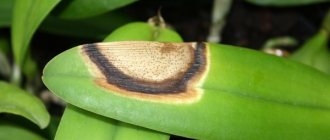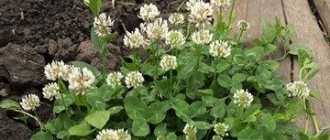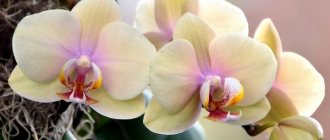What does it look like?
The peduncle is a long, bright green, step-shaped stem, most often appearing between the leaf blades of the orchid, at the top of which an inflorescence is formed. Its pointed tip is the same color as the shoot itself. The peduncle is not smooth: the plant buds “sleep” under the scales.
You can find out more about what a flowering stem is and what it looks like here.
What to do to make an orchid produce several flower stalks at the same time
At the same time, a flower can form 2-3 peduncles. Young growth often develops one stem, and even if you try, it will never produce more branches. Three stems can appear in an adult plant that has 9-10 leaves in a rosette and in some varieties of orchids that can shoot 4-6 arrows at the same time.
For any orchid, three or more flower stalks at once is a great depletion and shock. Energy goes into the formation of stems, the appearance of buds and the blooming of beautiful flowers. After abundant flowering, the flower needs rest and good care.
How to distinguish it from other parts of the flower?
Only a novice gardener may have difficulty determining the distinctive features of the peduncle from other parts of the orchid, for example, the root or basal baby. In fact, everything is very simple. It is enough to pay attention to some characteristics, and everything will fall into place.
- The shape of the root is round, the peduncle is cone-shaped, and the basal child resembles the open beak of a bird.
- At the base of the root collar, next to other roots, a root is formed, a flowering shoot appears only from the leaf axil, and a basal shoot appears from the center of the trunk.
- The arrow appears above the place of the previous flowering, most often grows upward, towards the light, but other directions are also possible; the root rushes downwards, towards the soil, towards moisture, but sometimes it can be directed to the side and upwards; the baby is growing upward (read about how to grow a baby on a peduncle here).
- The main difference: the peduncle necessarily has irregularities - buds, while the root is perfectly smooth, without any irregularities.
We invite you to watch a video about the differences between the peduncle and other parts of the orchid:
Photo
Next in the photo you can see what the peduncle of the plant looks like.
Care before and after flowering
There are certain requirements for caring for an orchid. It is necessary to strictly follow them, especially if the gardener wants to see his beauty bloom.
Experienced gardeners distinguish 5 life cycles of orchids: vegetation (growth of roots and leaves), dormancy (the period of release of the peduncle), flowering, rest, active vegetation (growth of new roots and leaves).
- Temperature.
The dormant period of the flower most often occurs in autumn (read about what to do with the arrow when the orchid has already bloomed). In order for an orchid to produce a flower stalk, it needs to be provided with maximum comfortable conditions. As a rule, in order for the plant to enter the dormant phase without stress, it is recommended to reduce the temperature level: from +25C to +15C. The main task is to ensure a noticeable difference between the thermometer readings during the day and at night. When the peduncle has already been released, the temperature rises slightly again. - Watering.
During the growing season, the plant is systematically moistened as needed. You can understand whether moisturizing is needed visually (the color of dry and moistened roots is taken into account) or tactilely (the moisture level of the top layer of the substrate).Before releasing the peduncle, the epiphyte is subjected to an artificial drought: another 4–5 days, possibly more, are added to the expected time of watering. This measure is explained by the fact that in its natural habitat - the tropics - the orchid blooms its flowers during the period of “drought”, since daily tropical downpours do not allow insects to fly from flower to flower, thereby pollinating them. An artificial drought in a flower pot will give the orchid a “signal”: it’s time to bloom!
When the peduncle has already been released, the epiphyte must not be forgotten to be watered, but this must be done again as the soil dries out. We remember the main rule: it is better to underfill an orchid than to overfill it. The recommended interval between waterings is from 7 to 12 days, depending on the living conditions of the beauty.
- Feeding.
If the orchid was fed before the release of the peduncle, then you should not stop doing this even after the shoot has been driven out until the first flower appears. Fertilizing is important before, not during, flowering.As a top dressing, it is advisable to use ready-made complex fertilizers for orchids containing nitrogen, phosphorus, and potassium. They are sold in specialized stores. If there was no fertilizing, then you should not start fertilizing the flower while the frog is grazing - the consequences can be very disastrous.
- Light.
Often, in order for the orchid to enter the resting phase, it is moved to a dark place. After the peduncle appears, the orchid needs to be provided with a lot of diffused light for its normal formation (southern, southeast, southwest windows).It is important that the daylight hours for the flower are at least 12 hours. If the growth of the arrow occurs in the fall (which happens most often), then it is necessary to provide the plant with additional lighting. Phytolamps are usually used for these purposes.
The orchid does not like drafts and air currents. The pot with the plant must be placed away from the air conditioner, fan, or radiator. Under no circumstances should an orchid with a growing peduncle be replanted to avoid a stressful situation for the plant!
Read more about what to do with an orchid after it has released a peduncle in a separate article.
Difficulties in growing
In the process of growing an orchid, certain difficulties may arise. As a rule, they are associated with illiterate care and can be easily resolved if the flower is provided with normal conditions.
Most common problems:
- Stopping the growth of the peduncle. It is caused by a change in the location of the orchid, a lack of light or fertilizer, as well as cold air in the room.
- A peduncle emerging from a growing point. This is evidence of a mutation or unsuccessful crossing. Such a shoot blooms once, but can form children. An orchid cannot die from a stem growing in the center, but you should not hope for full flowering in the near future. How long to wait depends on the correct care. Typically, complete rehabilitation takes from 5 months to six months.
- Drying of the young peduncle. Untimely transplantation, lack of nitrogen, potassium and phosphorus, and lack of difference between day and night temperatures lead to sad results.
If an orchid does not form buds for a long time, the reason may lie in its age. Young specimens simply do not have time to build up a strong root system and enter the stage of forming buds and children.
When caring for an orchid peduncle, it is important to adhere to measures. The plant loves stability, so moving it to a new place and especially replanting it during flowering is prohibited. If the exotic beauty was initially kept in the right conditions, it is enough to reduce watering and fertilizing when the bud appears. Then a scattering of lush flowers is guaranteed, no worse than in the photo in magazines.
Epiphyte problems
Doesn't release an arrow
If all care requirements are met, the orchid blooms once a year (maybe more often). Why sometimes doesn’t she put out a peduncle? There are a number of reasons for this. Insufficient lighting, incorrectly chosen substrate, lack of fertilizing, stressed state of the plant, improper watering - this is a list of the main negative factors affecting the condition of the epiphyte, and, consequently, its desire to bloom.
- If the orchid does not have enough lighting, then it does not produce a peduncle, but increases the mass of leaves. And when a peduncle appears, buds do not form on the shoot. The way out of the situation is simple: increase the volume of light, but avoid direct sunlight. In the summer, it is important to remember about shading the plant.
- If the substrate is chosen incorrectly or the plant is not fertilized, then the gardener does not need to harbor hopes of seeing his beauty bloom.
It is important to remember that the epiphyte loves moderation in everything: an excess of fertilizers can also negatively affect the condition of the plant. For feeding, it is better to use complex preparations intended only for orchids and purchased at a flower shop. For example, “Kemira Lux” or “Bona Forte”. Before use, be sure to read the instructions for these fertilizers. The same applies to the substrate: for planting or replanting an orchid, soil is used that is intended only for this flower. - Stress has two opposite sides. Sometimes experienced gardeners give their orchid “shock therapy” so that it produces a peduncle (cold, drought, darkness). But stress can have a detrimental effect on a flower. Be sure to remember that everything is good in moderation.
- Watering an orchid is one of the basics of flowering.
Moisture affects the formation of future peduncles and buds. If the epiphyte is watered excessively, the root system will certainly begin to rot and the buds will dry out. During the growing season, watering should be systematic, and after the buds appear, the frequency of watering is usually reduced. For the appearance of a peduncle, it is recommended to place the container with the orchid in a water bath for 1 hour; during the dormant period, watering stops completely. - Humidity. Orchid is a tropical plant that loves moist air. But not during the period of release of the peduncle. The humidity level in the room where the epiphyte is located should not exceed 30% - 40%.
From the video you will learn why an orchid does not produce a peduncle:
The arrow is released, but does not develop
Sometimes the flower stalk stops growing; there may be a number of reasons for this, which are almost identical to those listed above.
- Insufficient lighting. The solution is to move the plant to a more illuminated place.
- Rotten roots. The solution must be radical: the plant needs to be replanted. And although it is not recommended to do this during the release of the peduncle, here we are talking about the life of the entire flower as a whole.
- Insufficient watering. The solution is to adjust the watering scheme. You can cover the top layer of the substrate with sphagnum moss, which will promote additional moisture and also change the acidity of the substrate, after which the peduncle can begin to grow again.
The period of growth of the peduncle - from the moment of appearance until the appearance of the first flowers - is usually about two months.
Dries up
Sometimes the almost grown peduncle begins to dry out. Why? Here are some main reasons:
- Reaction to transplantation. The plant adapts to the new substrate and “sheds” excess parts. As a rule, these are the peduncle and lower leaves.
- No difference between day and night temperatures. In bright sunshine, all metabolic processes in the orchid begin to accelerate, new cells begin to form, and for them the flower needs carbon.
The supply of this element is replenished during the cool night time. If it is hot at night, the plant begins to experience a lack of carbon, and, therefore, take what is missing from its old cells. The largest reserve of carbon is contained in the peduncle, so it dies. - Lack of nutrients: nitrogen, potassium, phosphorus. They are also “pumped out” by the plant from its parts.
As a way out of this situation, experienced flower growers recommend cutting off the drying peduncle to living tissue. This can stop the drying out, and a new side shoot may grow from the dormant bud. If this does not happen, then the arrow will have to be cut off completely, leaving a stump of 1-1.5 cm, and wait for the next peduncle a few months later.
Unfortunately, the release of a flower stalk by an orchid does not always mean that it will soon bloom. For this to happen, you need to fulfill all the basic requirements for the care and maintenance of the flower.
And if this does not happen, there is no need to be upset, you just need to take into account all the nuances discussed in the article and wait for the next period of flowering of the epiphyte.
Step-by-step care instructions
So, what to do next when the orchid has already produced a peduncle? If you correctly follow all the tips and recommendations for care, the flowering will delight our eyes for a long time. Let's look at the most important points:
- Choosing a place - after throwing out the peduncle, the pot must be placed on the windowsill of an eastern or western window, where there is light and not scorching sun rays. If there is only one window and it faces the south side of the house, then only shading will save you from burns and other problems.
- Temperature - in the autumn - winter period, the temperature should be maintained within 20 - 25 degrees, this is a comfortable temperature for blooming Orchids. Night temperature changes should be minimal.
- Humidity - required humidity: 60 - 70%, it is not so easy to achieve it during the heating season, the air in apartments becomes extremely dry.
Of course, it would be good to use a special air humidifier, but this is ideal, and from available means, you can place a flower pot in a large container with water, at the bottom of which pebbles or expanded clay are poured so that the water evaporates. Recommendation. The orchid must be sprayed with warm water and only before lunch, after lunch it is not advisable. - Lighting - bright diffused light is required; when daylight hours become short, you definitely need to additionally highlight your flower so that the buds and flowers do not fall off; lack of light will immediately affect the appearance of the flower.
Watering - this plant, of course, loves moisture and during the period of flowering the soil should not be allowed to dry out, but it is strictly not recommended to over-moisten it (risk of rotting of the root system). If the orchid has thrown out its peduncle in the fall, then it will need to be watered approximately once a week and it is better to lower the pot into water to saturate the soil, then the water will drain and put it back in its place.- Fertilizing is absolutely necessary at this time, apply about twice a month, it is better to use special liquid fertilizers for Orchids, everything is balanced there.











